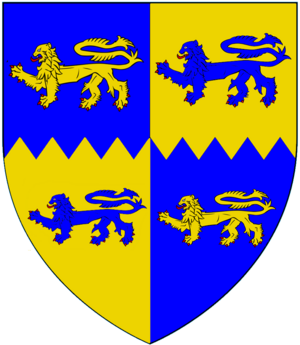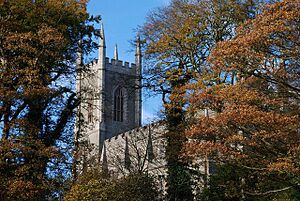Edward Cromwell, 3rd Baron Cromwell facts for kids
Quick facts for kids
Edward Cromwell
|
|
|---|---|

Arms of Cromwell, Baron Cromwell: Quarterly, per fess, indented, azure and or, four lions passant
|
|
| Born | Edward Cromwell c. 1559 Launde Abbey, Leicestershire |
| Died | 27 April 1607 (aged 47–48) Downpatrick, County Down |
| Resting place | Down Cathedral, Downpatrick 54°19′37″N 5°43′21″W / 54.327061°N 5.722547°W |
| Title | 3rd Baron Cromwell Kt PC |
| Tenure | 1592–1607 |
| Nationality | English |
| Residence | Launde Abbey |
| Locality | Leicestershire |
| Offices | Governor of Lecale |
| Spouse(s) | Elizabeth Upton Frances Rugge |
| Issue | with Elizabeth: Elizabeth Cromwell with Frances: Thomas Cromwell, 1st Earl of Ardglass Frances Cromwell Anne Cromwell |
| Parents | Henry Cromwell, 2nd Baron Cromwell Mary Paulet |
|
|
|
Edward Cromwell, the 3rd Baron Cromwell, was an important English nobleman who lived from about 1559 to 1607. He was the son of Henry Cromwell, 2nd Baron Cromwell and Mary Paulet. His grandfather, Gregory Cromwell, 1st Baron Cromwell, was made a Baron in 1540 by King Henry VIII.
Contents
Edward Cromwell's Life
Early Life and Family
Edward Cromwell was born around 1559 at Launde Abbey in Leicestershire, England. He studied at Jesus College, Cambridge, but he did not officially graduate. He later received a special Master of Arts degree in 1594.
A Life of Service
Military Adventures
Edward Cromwell had a career that involved both military service and politics. In 1591, he served as a colonel in the English army. This army was sent to help Henry IV of France in Normandy. When his father passed away in 1592, Edward became the 3rd Baron Cromwell.
He also volunteered in a naval mission against Spain in 1597. In 1599, he was knighted by Robert Devereux, 2nd Earl of Essex, after serving in another expedition against Spain. There were reports that he defeated a large rebel force that same year.
Trouble and New Beginnings
Edward Cromwell became involved in Essex's rebellion in 1601. This was an attempt by the Earl of Essex to start a revolt in London. Edward was arrested and sent to the Tower of London. He said he didn't know about the plan and just happened to be with the Earl of Essex.
His wife asked the council if he could get some fresh air because he was unwell. They agreed, allowing him to go outside with a guard. Edward confessed to some involvement and was fined £3,000. He was imprisoned for several months but was later pardoned by Queen Elizabeth I in July 1601.
After this, Edward Cromwell was not in the Queen's good graces. He also had many debts and lawsuits. He had to sell some of his land. He was advised not to attend Parliament. He often wrote to Sir Robert Cecil, asking for help to get back into the Queen's favor.
When King James I became king, Edward Cromwell was made a member of the Privy Council. He sold all his English property to Charles Blount, 8th Baron Mountjoy and moved to Ireland. In 1605, he made an agreement with an Irish chief, Phelim McCartan, to receive land in County Down. He also became the governor of Lecale. In 1606, he bought the Barony of Lecale and built a large house in Downpatrick.
Family and Legacy
His Marriages and Children
Edward Cromwell married twice. His first wife was Elizabeth Upton, whom he married in 1581. They had one daughter:
- Elizabeth Cromwell, who married Sir John Shelton and later Thomas Fitzhughes.
Around 1593, he married his second wife, Frances Rugge. They had three children:
- Thomas Cromwell, 1st Earl of Ardglass, who later became the 4th Baron Cromwell.
- Frances Cromwell, who married Sir John Wingfield.
- Anne Cromwell, who married Sir Edward Wingfield.
Later Life and Passing
Edward Cromwell passed away at his home in Downpatrick on April 27, 1607. He was buried in the old part of Down Cathedral on September 24, 1607. Sir Arthur Chichester expressed sadness at his death, noting it was a loss for the king's service and for Edward's family.
His son, Thomas, became the 4th Baron Cromwell. Thomas later became the 1st Viscount Lecale and then the Earl of Ardglass. The title of Baron Cromwell ended in 1687 when Vere Essex Cromwell, the 7th Baron, died without children.
A Special Tradition
In 1631, Edward Cromwell's son, Thomas, visited his father's former manor of Oakham. There, he took part in an old tradition. He gave a horseshoe as a tribute to the Lord of the Castle and manor of Oakham. This horseshoe can still be seen today in the great hall of Oakham Castle, alongside others given by royalty and nobles. Thomas Cromwell died in 1653 and is buried in Tickencote, Rutland. His son, Oliver, put up a memorial for him near where Edward Cromwell is buried in Down Cathedral.


